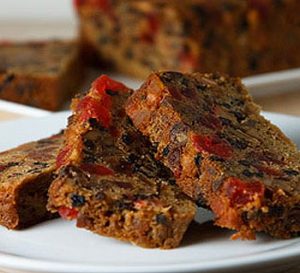‘The Christmas Fruitcake” by Henri Marchand

The Christmas Fruitcake: An Ageless Tradition
by Henri Marchand
I think there is no yuletide tradition so endlessly lampooned and so deliciously mocked as the once esteemed fruitcake. Everyone loves chestnuts roasting on an open fire, and even plum pudding gets an annual endorsement by the beloved Cratchits, but mention fruitcake and people tend to giggle. Johnny Carson suggested that there exists but one fruitcake in the world; it just passes from one unappreciative family to another. Calvin Trillin is reported to have commented that “There is nothing dangerous about fruitcakes as long as people send them along without eating them.” And in Manitou Spring, Colorado, the Chamber of Commerce sponsors an annual Great Fruitcake Toss. The record is 420 feet, the waste immeasurable.
Unpopular as they may appear to be, a web search turns up over two million fruitcake hits. Mail-order bakeries began selling them in 1913, and now sell thousands every year. There were times when the fruitcake was revered. Early recipes date to ancient Rome and evolved over the years. The modern fruitcake originated in the Middle Ages with honey, rare spices, and hard-to-get preserved fruit from the Far East. In the 18th century, nuts were incorporated, the cakes eaten for good luck with the following year’s harvest. Due to the expense of the ingredients and a difficult baking process, fruitcakes were once restricted by law in Europe to special events like weddings and Christmas. Today, the fruitcake is pretty much a Christmas tradition. (Has anyone ever heard the refrain, “The bride cuts the fruitcake!”?) There are many types of fruitcake, but basically they’re all a pile of fruits and nuts glommed together with a minimum of batter and often dusted with powdered sugar and soaked in liquor for added flavor and shelf life.
When it comes to fruitcake, everyone takes sides. As in politics, there are two camps, each sharply opinionated—those who have bitten the hallowed fruitcake and those who would rather die. Of those with a taste for this yuletide dessert a number partake openly while others do so surreptitiously, stealing a morsel when they think no one is looking. Among those few bold enough to discuss their addiction, there are particular preferences. Some fancy the lighter, citron based variety, while others crave cakes with a higher nut content. Some drool over the dry, crumbly variants, others lap up the glazed and gooey sorts. In my early years I never cared for the bland flavor of citrus bits or their texture, which I found not unlike that of pencil erasers.
I developed an affinity later in life, and I have baked a pair of cobblestone-sized loaves annually for over a decade. I do so with great holiday cheer despite loud family protestations. The recipe I follow is out of a dog-eared cookbook, a dark molasses-rich block chock-full of candied cherries and pineapples, dates, and golden raisins. But I’ve modified the mix over the years and use shelled walnuts instead of Brazil nuts. Mainly it’s because I prefer the taste of walnuts. It’s also because shelling Brazil nuts is like disarming grenades. You need a deft touch, applying just enough pressure, otherwise the crescent shaped, steel-like shells explode, scattering shrapnel all over the place and turning the nutmeat to mush. A pound of nuts produces a measly two-to-three usable, undamaged pieces. Cutting up the fruit is no less challenging. Thickly sugared pineapples and naturally tacky dates stick to knives, cutting boards, and fingers. Many end up in my mouth. This year I’m going to add dried apricots to the mix and drown one of the finished cakes in brandy or bourbon, an added inducement for those who have yet to indulge themselves.
I’ll do this because I’ve noticed that there are not many takers when I wheel out the fruitcake on Christmas Eve. I don’t push it on anyone or suggest that they try “just one little piece.” I just slice it and let it speak for itself at the front of the buffet table under a small spotlight. Oh, several guests are polite and compliment its jeweled appearance and my stubborn adherence to tradition, but there aren’t many slices missing by midnight. Others shake their heads, and say, “no thanks, I don’t do fruitcake” as if refusing a casual offer of an illegal substance. Some groan dramatically and cry, “Oh, no, no, I’d love to, but I just couldn’t eat another bite,” even as they shovel down handfuls of peanuts and mouth another meatball. Still others simply sniff in mock derision, roll their eyes, and say things like, “Yeah, right, Dad!” Apparently, Santa’s no fan either, as the thick slices left for him by the tree are still there Christmas morning while the chocolate milk is gone.
I know the merry barbs are coming from the anti-fruitcake faction, and the remains of my effort will linger long after the holidays, but I don’t care. I like fruitcake! I’ll enjoy slivers of these ageless bricks for the next six months. Or until the spirit of the season abandons me in April and I toss the lot of what’s left to the squirrels and birds.
Thank you. You’ve brought back memories of fruit cakes made by my grandmother each Christmas. I actually really like fruit cake a lot! And “cobblestone”- size loaves? Must be a Lowell thing. Never heard it described that way. But, yes, loaf-shaped, often baked in a coffee can.
Grandmother’s fruit cake was moist, very rich and heavy. She also make wonderful pies, plum pudding with a brandied hard sauce – she preferred to bake in her trusted wood-fired stove.
Vote 1 for fruit cake.